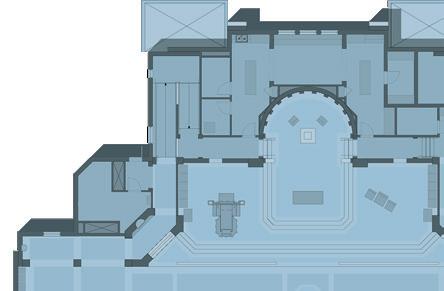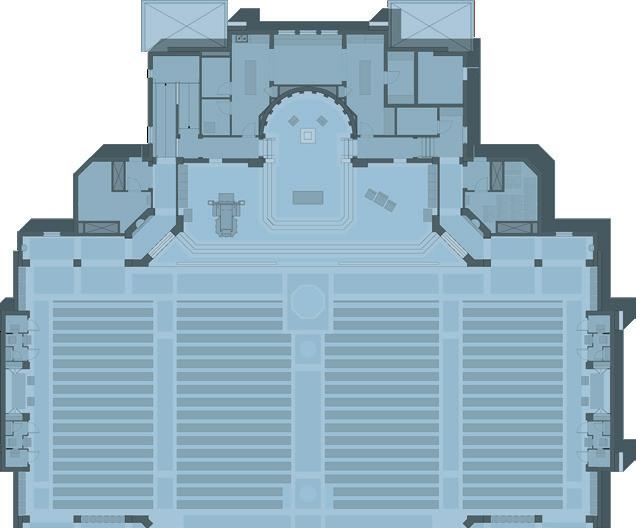
5 minute read
The Stained Glass Windows Above the Confessionals on the Right Side
St. Dominic (1170-1221) St. Dominic was born in Spain to a wealthy family. While his mother was pregnant with Dominic, she had a vision that her unborn child was a dog who would set the world on fire with a torch it carried in its mouth. The dog bearing a torch would later become a symbol of the Dominican religious order. In 1215, after years of traveling and boldly preaching the Good News of Jesus Christ, Dominic founded a religious house in Toulouse, France. This became the start of the Dominican religious order, which is also known as the Order of Preachers. Dominic received a vision from Our Lady in which she showed him a wreath of roses, representing the rosary. She told him to say the rosary daily, to teach it to all who would listen, and to spread the devotion of the rosary to the world. St. Dominic is the patron saint of scientists and astronomers.
Feast Day: August 8th
Advertisement
Flower Border: Stars, honoring the vision of Dominic’s grandmother who saw a star on his forehead at his Baptism

Bottom Image: Reception of the Rosary from Mary

Right Aisle




St. Francis of Assisi (1181-1226) St. Francis grew up in Italy within a wealthy family. He loved playing sports and was a knight in the Assisi army. At age twenty-four, Francis prayed in a tiny church in San Damiano, and Christ spoke to him from the crucifix saying, “Rebuild my Church.” Francis renounced all of his riches in a main plaza and recognized his vocation to rebuild the spiritual life of the Church by bearing witness to the saving power of the Gospel. In 1210, St. Francis began the Fransiscan religious order, which embraced a life of radical evangelical poverty and prayer. During a moment of ecstasy in prayer, St. Francis received the stigmata (the wounds of Christ). St. Francis also created the first manger scene, characterizing Christmastime with the Incarnation—when the only Son of God took on human flesh in Jesus Christ. Francis is the patron saint of ecology and animals.
Feast Day: October 4th
Flower Border: Butterfly, evoking Francis’s love for nature and his lived hope in Christ’s resurrection through poverty
Bottom Image: Francis encountering a leper in the city. Francis suddenly perceived in this leper the embodiment of God’s beauty, a human being to be loved and cared for tenderly. By embracing the leper, Francis learned to embrace the poorest of the poor as Jesus did.
St. Ignatius of Loyola (1491-1556) St. Ignatius was born in Spain and became a military man. During a battle in which Ignatius stubbornly refused to retreat, a cannonball shattered his leg and sent him into a long period of recovery. During these recovery months, Ignatius requested books about war and romance; since none were on hand, he instead spent his time reading a life of Christ and lives of the saints. His conscience was deeply touched, and a beautiful conversion to Christ began. St. Ignatius eventually founded the Society of Jesus, now commonly known as the Jesuits. He was also a true mystic, teaching his friends to encounter Jesus in Scripture through measured sensitivity to their human senses and emotions. His spirituality is expressed in the Jesuit motto, Ad majorem Dei gloriam—“for the greater glory of God.”
St. Ignatius is the patron saint of soldiers, educators, and spiritual retreats. Our Aggie Corps of Cadets can especially find solidarity with St. Ignatius’s military background and humble submission to the greatest heroism of Jesus.
Feast Day: July 31st
Flower Border: Oak, symbolizing wisdom and strength, common in the Basque Region of Spain
Bottom Image: Ignatius’s cannonball injury
Right Aisle
Divine Mercy Chapel: The second side chapel in the church is dedicated to Divine Mercy. This devotion is connected to St. Faustina’s 1931 private revelation of blood and water pouring forth from the Sacred Heart of Jesus for the salvation of all souls.
Feast Day: Sunday after Easter


Right Aisle




Statue— St. Thomas Aquinas (1226-1274) St. Thomas Aquinas was an influencer of his time, known as the greatest philosopher-theologian of the medieval period. He was born in Sicily and became a Dominican friar and priest. As a Dominican, Thomas wrote his understanding of a tremendous volume of Church doctrine called the Summa Theologiae, all with the intention of instructing his fellow brothers on how to teach the faith effectively. He wrote with incredible insight and yet profound humility. After Thomas’s canonization, he was proclaimed a Doctor of the Church. Students can ask for his intercession when praying for wisdom. The statue also honors St. Thomas Aquinas Catholic Church of College Station, which was founded as a daughter parish of St. Mary’s in 1982.
Feast Day: January 28th
St. Louis de Montfort (1673-1716) St. Louis de Montfort was a French missionary priest who joined the Dominican order in 1700. As a boy, he listened to the stories of a local priest who was an itinerant missionary and desired to preach to the very poor. This priest also fostered Louis’s profound devotion to the Blessed Mother and his eventual promulgation of the Rosary. St. Louis’s theology can be summarized as “Total consecration to Jesus through Mary”; as Christ entrusted Himself to the womb of the Blessed Mother in the Incarnation, so too can we entrust ourselves to the will of God under the care of Mary. St. Louis is the patron saint of preachers, inspiring in his love for Mary and his missionary zeal.
Feast Day: April 28th
Flower Border: Rosary Beads
Bottom Image: St. Louis before the Blessed Virgin Mary and Child Jesus
St. John Bosco (1815-1888) St. John Bosco or “Don Bosco ‘’ grew up in Italy to a poor family. Don Bosco dedicated his priesthood to teaching and working exclusively with the poor children and youth in the city of Turin. He served as chaplain in a hospice for wayward girls; feeding and clothing the poor was his other main concern. Don Bosco used illusions and humor to interest these children in the faith and to draw them into a relationship with Jesus. He established the Society of Saint Francis de Sales, also known as the Salesians, to carry on his charitable work with children. At his canonization, he was given the title “Father and Teacher of Youth.” He is the patron saint of young people and magicians.
Feast Day: January 31st
Flower Border: Lily, symbolizing the chastity by which he was able to give himself entirely to the young and the poor
Bottom Image: John Bosco with the boys of Turin
St. Maximilian Kolbe (1894-1941) St. Maximilian Kolbe was a Polish Franciscan friar who had a special devotion to the Blessed Mother and ran a religious publishing press. He was imprisoned by the Nazis in 1941 and sent to the concentration camp in Auschwitz. Kolbe celebrated Mass secretly in the camp and fostered trust in God through Mary. He is known for saying, “Do not be afraid of loving the Blessed Mother too much; you can never love her more than Jesus did.” When a group of prisoners at Auschwitz was to be starved to death in retaliation for an escape, one of the condemned men with a family begged for mercy. Kolbe volunteered to take his place and sacrificed his own life to save another. This martyr is the patron saint of drug addicts, prisoners, and the pro-life movement.
Feast Day: August 14th
Flower Border: Blackberry, representing sorrow for death and the crown of thorns shared in martyrdom
Bottom Image: Maximilian Kolbe giving his life for the imprisoned man


